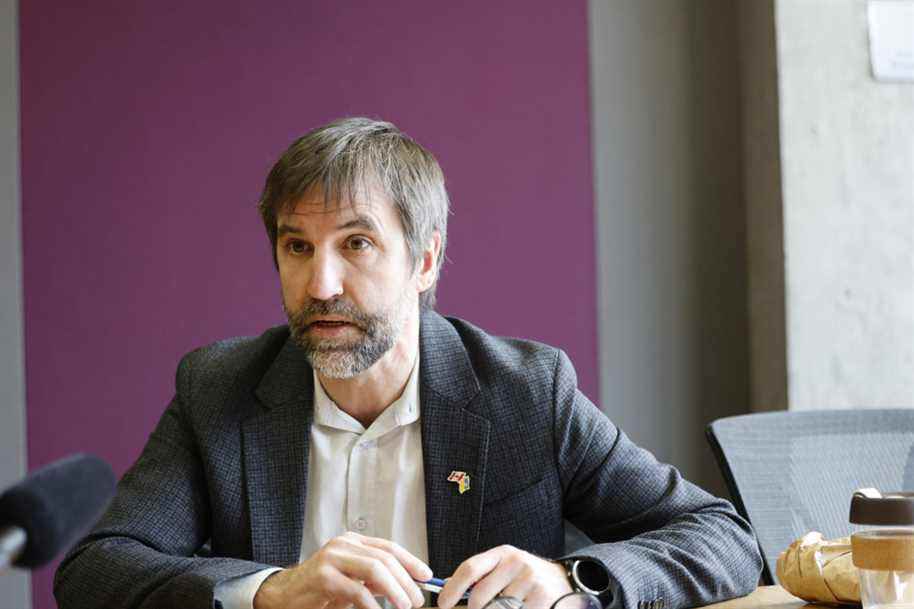Posted at 5:30 p.m.
(Montreal) Ottawa’s plan to reduce Canada’s greenhouse gas (GHG) emissions by at least 40% by 2030 is an effective mix of incentive and coercive measures, Steven Guilbeault said on Friday during of a media meeting to which environmental demonstrators were invited.
“It’s a happy marriage between a carrot and a stick,” said the Minister of Environment and Climate Change, citing on the one hand the financial support measures for the decarbonization of the various sectors of the economy and , on the other, carbon pricing.
“We are staying the course, we are going to $170 a ton” while investing hundreds of millions of dollars for the energy transition, he explained during a discussion with a small group of journalists, after having met with environmental organizations in Montreal.
Minister Guilbeault rejects criticism that his plan, released Tuesday, does not detail concrete ways to reduce GHG emissions by 287 million tonnes by 2030.
He cites the reduction of methane emissions from the oil and gas industry, which is on track to meet the target of 45% by 2025; the Clean Fuel Standard, which will gradually reduce the carbon intensity of fuels; as well as the capping of emissions from the exploitation of fossil fuels.
I think that’s pretty drastic for one of the biggest oil and gas producing countries in the world.
Steven Guilbeault, Canada’s Minister of Environment and Climate Change
The work does not stop with the filing of the reduction plan, argues Minister Guilbeault, referring to “several draft regulations” being developed and regular reporting that will make it possible to adjust the course as needed.
“The more we go forward in time, the more things will become clearer,” he assured.
The measures already adopted are also beginning to bear fruit, rejoices the Minister, pointing out that the inventory of Canada’s GHG emissions for 2019, published last year, “shows very well that we have flattened the curve”.
And the 2020 emissions inventory, to be released by April 15, will contain “good news”, he promises.
CO capture and storage2
Steven Guilbeault defends the place given in his plan to the capture and storage of carbon dioxide (CO2), technologies that remain embryonic and expensive.
Reducing emissions will not be enough to limit global warming, it will also be necessary to remove carbon from the atmosphere, recalls the minister, a few days before the publication on Monday of a new report by the Intergovernmental Panel on Climate Change (IPCC), which will look at ways to reduce greenhouse gas emissions.

PHOTO MARTIN CHAMBERLAND, THE PRESS
Minister Steven Guilbeaut visiting the Maison du développement durable on Friday in Montreal
“Capture and storage is not the beginning of our strategy to fight climate change, it comes at the end,” said the minister, who considers it to be one tool among many. others, such as nature-based solutions, in which Ottawa is investing heavily.
“We believe very, very much in nature-based solutions,” he says, pointing out that they cost less than technological solutions.
But Ottawa cannot act alone to reduce Canada’s greenhouse gas emissions, said Minister Guilbeault, who recalled that the production and use of natural resources are under provincial jurisdiction in Canada.
Would Canadian climate action be more effective if all the provinces rowed in the same direction as us? Absoutely.
Steven Guilbeault, Canada’s Minister of Environment and Climate Change
Radiance
About fifteen demonstrators burst into the hall of the Maison du développement durable, after the meeting between Minister Guilbeault and environmental groups, and continued to make themselves heard during the Minister’s meeting with the media.

PHOTO MARTIN CHAMBERLAND, THE PRESS
About fifteen demonstrators burst into the hall of the Maison du développement durable, after the meeting between Minister Guilbeault and environmental groups.
“Steven Guilbeault, keep your word, we must say no to oil,” they chanted, among other things, calling on the minister to reject the Bay du Nord project, a floating oil and gas extraction facility that Norwegian Equinor wants build off Newfoundland and on which he must render a decision by April 13.
“A few years ago, I probably would have done the same thing,” said Steven Guilbeault after speaking with their representatives for a few minutes.
“We believe Minister Guilbeault knows how important climate change is, we know he knows what the right decision is [à prendre]. The question is: will he have the courage to make the right decision? said Shirley Barnea, CEGEP student and member of the group Pour le futur Montréal, which organized this stunt with the Student Coalition for an Environmental and Social Shift.
Tramway and third link
The federal government is an “unwavering ally” of the Quebec City tramway project, reiterated Steven Guilbeault, after ten days of acrimonious debates on the subject in the Old Capital. “When you look at what all the experts in planning and public transit have said about this project, it’s an excellent project,” he added, saying he was hopeful that it would the front. Asked about the project for a third road link between Quebec and Lévis, Minister Guibeault recalled that Ottawa no longer invests in the construction of new infrastructures. If a project were submitted, the “public transport component” could possibly be financed up to 40% by federal funds, specified the minister. “It’s not 40% of the whole project, as some have suggested. »
Learn more
-
- 730 million
- Canada’s greenhouse gas emissions in 2019, in tonnes
Source: Department of Environment and Climate Change Canada
- 443 million
- Canada’s greenhouse gas emissions target for 2030, tonnes
Source: Department of Environment and Climate Change Canada

